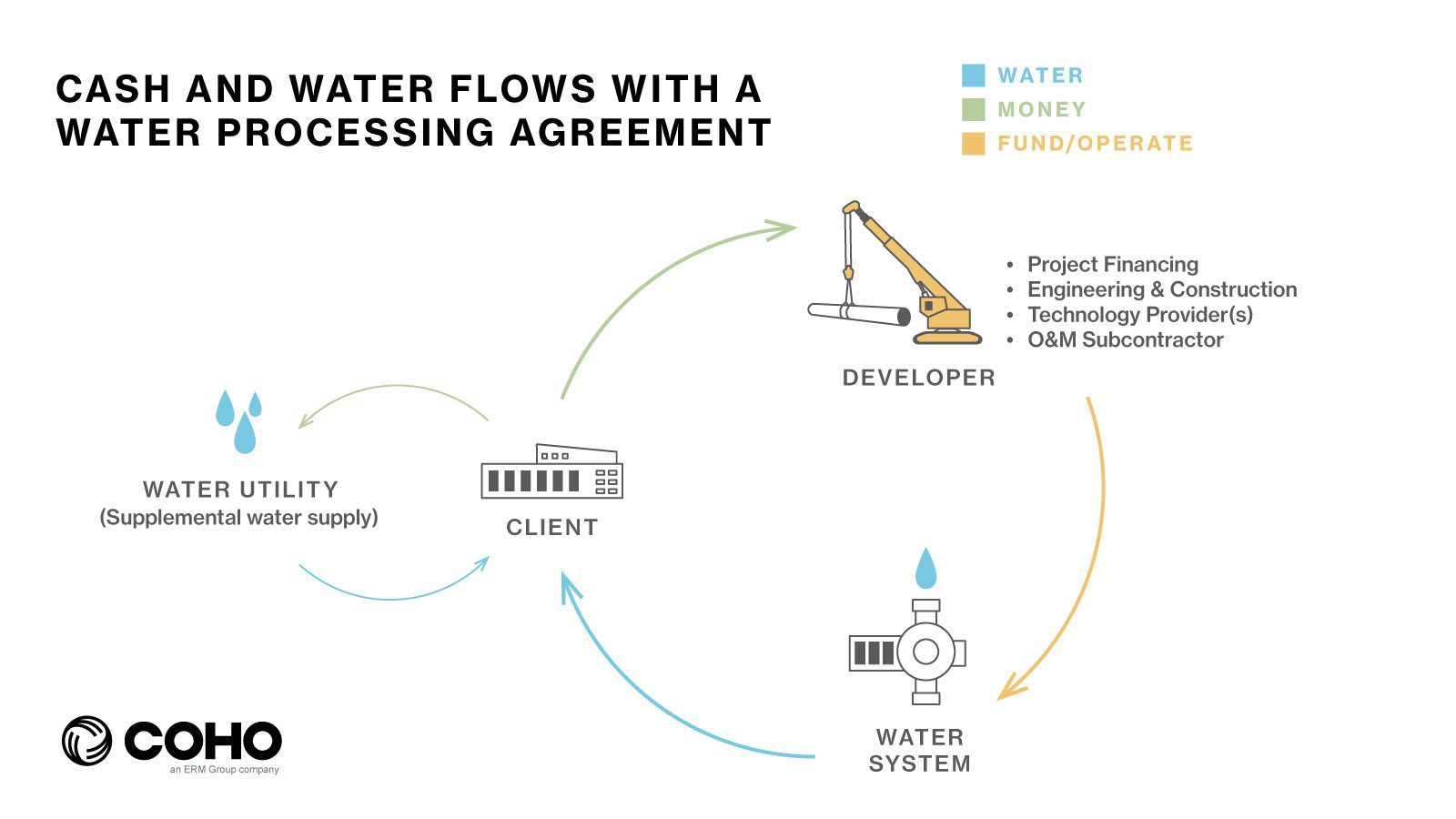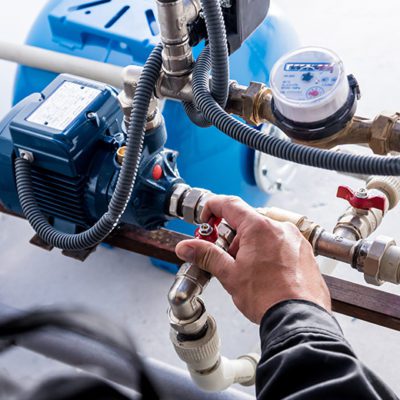You know the seriousness of water risk and you’ve heard the call for better corporate water stewardship. Now, you have big ideas for shrinking your organization’s water footprint. But how will you pay for them? Consider a water processing agreement.
Some organizations have the appetite to fund water resiliency projects out of their own balance sheet. Others find that water projects are shot down during normal budget processes due to limits on the scale and pace of capital deployment. The good news is there are creative methods to fund water resiliency projects, including via third-party developer financing.
Challenges to Funding Water Projects
Traditionally, water improvement projects must be approved through an organization’s standard capital approval process to obtain funding. While this process is often an efficient way to prioritize projects, water solutions can be at a disadvantage because:
- they must compete against other infrastructure projects and business plans (e.g., growth, production lines, technology upgrades), some of which are viewed as more central to core business functions;
- they may have longer payback periods than companies are used to, sometimes 7+ years;
- capital budgeting processes don’t account for additional project benefits, such as risk reduction, improvements to safety, sustainability benefits, and operational efficiencies; and the long-term operation and maintenance may require expertise beyond the current facilities team.
Water projects are then stuck in limbo; the facilities and sustainability teams understand the needs and benefits, but the projects don’t clear the necessary hurdles for capital approval.
An Alternative: Third Party Financing
For some infrastructure projects, such as wastewater reuse systems, industrial gas purchases, or utility upgrades, there’s another avenue to achieve funding: identify a third-party developer to fund the project. You may be familiar with this concept in the energy space, often referred to as “energy-as-a-service.” These contracts can take several forms, including a concessionaire’s agreement, energy service contract, or a power purchase agreement. Water is no different; companies can explore “water-as-a-service” to fund projects that struggle for internal funding.
While each type of water-as-a-service contract is unique, they all involve a third party taking responsibility for infrastructure capital costs, charging the customer over time, and often generating savings compared to business as usual.
To illustrate the potential of water-as-a-service, we’ll focus on one contract structure: the Water Processing Agreement, or WPA. Using a stormwater or wastewater reuse WPA as an example, an external project developer funds, constructs, owns, and operates the new water equipment, and in exchange, the host company agrees to pay for the water processing services over time. For those familiar with onsite solar power purchase agreements (PPAs), a WPA acts in a similar manner.
(Coho can help manage this arrangement. We can serve as a program manager, guide the RFP, manage contract negotiations, perform bid analyses, and provide ongoing technical guidance and commercial leadership.)
In some situations, the price a company pays for water under the WPA is less than what they would have paid to their water utility or water treatment supplier. Companies are also spared the operations and maintenance effort and facilities teams don’t need to devote significant time to learning new technical capabilities. Additionally, the company receiving the water can design the WPA pricing structure such that it only pays for the amount of water processed, meaning they won’t lose money if the project fails to perform as expected.
Case Study: Thinking Creatively Can Result in Real Impact
We can take a recent Coho client’s case as an example. We worked with them to execute a WPA for a stormwater reuse project at one of their main campuses. The project will filter water from an onsite stormwater pond and use the filtered water to supply the site’s cooling towers, allowing the facility to reduce potable water consumption by nearly 70%.
The project began with a feasibility assessment supported by Coho and preliminary engineering to estimate upfront costs, water and cost savings, and technology requirements. Coho and the client then socialized the opportunities internally, working through the normal budgeting process to determine if and when the client would receive funding to proceed. It quickly became clear that due to a longer payback period and tight budget restrictions, budget approval would take years, if it happened at all. The timeline for this opportunity was critical in helping the client reach its broader sustainability goals and boost site resiliency, so the client decided the best (and fastest) path to implementation was through a WPA.
Coho led a competitive procurement to identify the best developer for the client. Through the RFI and RFP process, the team evaluated each bidder on expertise, economics, and creative mindset. This step was important to ensure whichever developer was chosen was reliable and the risk to project completion was slim. Once the client settled on a project developer, Coho and the client worked closely with the site facility team and the developer to ensure all parties understood technical aspects of the project, roles and responsibilities of each party, and criteria for success as contract negotiations progressed.
Here are example evaluation criteria for selecting a financing and development partner:
| Competency | Competitiveness | Creativity |
|
|
|
The project is currently in development, with commercial operations scheduled for early 2024. Additionally, this project is serving as a pilot for other sites owned by the client. We were able to reflect on lessons learned from the first WPA and ensure future WPAs could scale across the client’s portfolio.
More About Water Processing Agreements
If you’re considering using third-party funding to implement water projects, there are several additional points to keep in mind and share with your teams:
- Creativity is key, both for the company and the project developer. There are likely to be bumps in the road as you work through project design, contract negotiations, permitting, and construction, but the bumps don’t need to halt progress. Having a team that’s open to group problem solving ensures you can adapt when needed and identify good opportunities.
- In addition to creative thinking skills, it’s important for project developers to have strong expertise in financing, technology review, design, engineering, construction, and operations and maintenance. These skills can come from in-house personnel at the development company or through qualified subcontractors, but due diligence before selecting your counterparty is critical to project success.
- Incorporating accountability metrics into the agreement can bring peace of mind to your organization by ensuring the developer delivers on the promised facility operations. For example, contract terms can penalize the developer if the construction schedule is delayed, or the equipment does not operate as expected.
- WPAs may include contract terms that are structured differently than your organization is accustomed to. Involve a broad group of stakeholders early to understand contracting “must haves.”
- Coho has experience minimizing balance sheet implications. This requires close collaboration between the company’s accounting team and the project developer.
For some projects, or project portfolios, WPAs and similar third-party agreements are an effective tool to accelerate impact, allowing companies to implement projects and scale up faster than through existing budgeting processes. Doing so successfully requires a combination of technical awareness, program management, and commercial acumen. If you’re unsure where to start, or you don’t know if third-party financing is feasible in your situation, Coho is here to help you weigh your options and start down the right path.




